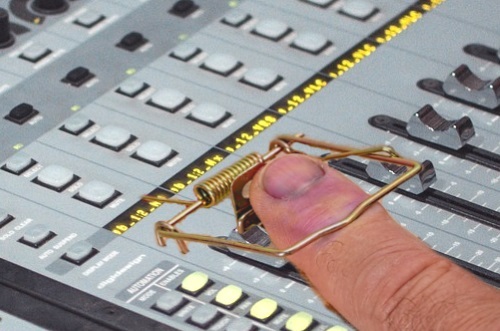There are many things which shouldn’t happen during a worship service, yet still do. However, unless we’re cognizant of them sometimes it’s hard to prevent them.
So I decided to create a list of those things that just shouldn’t happen in a worship service. Some of these may seem so silly, so expected, so taken for granted that they’re almost not worth saying.
But you’d be surprised how many times I’ve seen these mistakes made in other churches, and even by my own volunteers.
Don’t miss microphone cues
We can’t afford to not have a mic turned on when it needs to be on. But if you come to one of my workshops, you’ll hear me talk about keeping the number of open mics to a minimum.
That is to say, if the choir’s not singing, don’t have their mics open. If the pastor’s not talking, don’t have his mic on. And so on. But we also need to stay focused so that the pastor doesn’t have to say stuff to the congregation like “Is this thing on?” What an embarrassment.
Turn off the mics before they hit the stand
It’s purely unprofessional to let a singer put a mic in the clip on a stand without having first muted that channel. If you don’t, the congregation is going to hear a loud thump over the system, or at least over the monitors.
Hopefully the channel mutes on your console also mute the monitor mixes. That way all you have to do is mute each vocal mic channel, and they’ll be muted both in the house and in the monitors simultaneously.
Mute the guitar channels
Don’t you just hate the loud “buzzzzz-t” that goes with a guitar cable being plugged in or unplugged with the channel open!
If we can equate the word professional with excellence, then it’s unprofessional to not mute those channels in time to save the congregation from that moment. It’s a two-way street though. The sound guys aren’t mind readers, nor have they been assimilated to become one with the automation of the console.
With all that to say, the guitar and bass player in your worship team should give you a moment to mute their channels before unplugging. It’s just common courtesy, a recognition that we’re a team, that the tech support guys and the musicians arc equal members of the worship team.
If it needs a mic, then mic it
I once watched a sound guy at a church realize that he had forgotten to put a mic on an instrument on stage, and then decide that it was just too much trouble to bother going all the way back downstairs to add the mic. Hmm, not worth the bother?
Teach your backing vocalists where to stand and how to use a mic
Would someone please tell me why most backing vocalists stand so far away from their stage monitors? I don’t get it.
At one church I used to work at, our vocalists were very compliant and stood where we told them to stand—so they could sec down the throat of the HF horn in their stage monitor. Yet I’ve seen so many vocalists who run away from their monitor. You ask them if it’s too loud and they’ll say no. But they refuse to stand where it will do them the most good.
Those vocalists I used to work with were also careful not to hold their mic to their sides facing down between songs. They simply held it about at their waist, still pointed up.
Think about it. If your vocalists drop the mic to their sides between songs, the zero degrees on-axis point of the mic is going to be aimed at the monitor, which is likely going to make it feedback. There’s nothing worse than 2,000 pairs of eyes from the congregation looking at you when you did nothing to cause the problem.
Tighten up the fittings on boom stands
One day in college, I was helping set up for a jazz concert. I had been given the responsibility of setting the mic stand with a boom arm and a rather heavy mic on the end of it for a guest saxophone soloist.
At one point during the performance (of course, during a saxophone solo) that boom arm started to slowly drop lower and lower. Guess who was sent out to fix the problem! That’s another mistake I’ve not made since it happened. I’d encourage you to learn from my mistake. (Hey, get your own instead!)
Don’t stop mixing between songs
Remember the technique of bringing the worship leader’s fader up between songs so the congregation can hear what’s being said?
Well, if your pianist or keyboardist continues playing between songs, go ahead and pull their faders or submaster down about -20 dB or so. They don’t know how loud they are in the house mix. Even if they’re playing softer, it may not be soft enough. It’s your job to maintain a great musical mix, even between the songs.
Don’t forget to practice
It’s just amazing to me that musicians and vocalists – people who are used to practicing on their own – have to be reminded of the need to practice as a group. I’ve seen the same scenario repeated countless times around the world.
Don’t create a visual distraction during a worship service
Investing your time and God given talents in the tech support ministry is great. But remember that it’s an unseen activity that helps ministry.
Do your best to keep it that way. If you need to walk out into the auditorium during a worship service, plan your route to offer the least possible distraction to the congregation. If you need to talk on the intercom, do so quietly so that others around you won’t be distracted.
If you need to get a message to one of the musicians or singers on stage during a worship service, see if there’s a way to talk to them quietly over the monitors rather than sending someone on stage with a note. That’s another perfect reason for headphones instead of monitors.
Leave the sudden light changes to drama
Unless it’s for dramatic effect, the light changes both on stage and in the house should be slow. If possible, they should be so slow that the audience really isn’t aware that a change is being made.
Dim the house and stage lights for video presentations
If your church sometimes uses videotaped segments to underscore part of the pastor’s message, or for other things, you can really help the congregation see the screens better if you’ll dim the house lights a bit during that presentation, then bring them back up afterwards.
Stay plugged in!
This is a given, but I’ve seen this happen to too many tech support volunteers – myself included, This constant commitment to pursue excellence requires vigilance on our part, but it cannot replace our relationship with God.
If we get lost in the fun of twiddling knobs and playing with the gear, and in so doing forget why we’re doing this in the first place, then God won’t honor our service. So, don’t work every service. You and your family need time to immerse yourselves in the worship services as well.
While this list is far from comprehensive, hopefully you have found it illustrative. What other things can you think of which shouldn’t happen during a worship service?




















